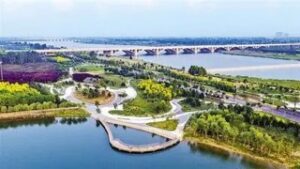Hutuo River
February 6, 2023 By: Jiayi Han
Location: Hutuo River, 中国

I live in Shijiazhuang, China, a city located in the plains of northern China. The Hutuo River is the most important river in our city. However, in the mid-1970s, the Hutuo River broke off and the river became so sandy that it gradually turned into a belt full of rubbish.
This is because the area through which the river flows has long been an area of severe water shortage and also particularly polluted. With insufficient surface water supply, there has been massive over-extraction of groundwater, resulting in the largest existing cluster of groundwater leaks in the world in Hebei. To make matters worse, with such a fragile water environment, illegal seepage pit discharges occur throughout Hebei, with the Hutuo River basin being the most concentrated of these areas. Surface water faces the same encounter, and despite the fact that surface runoff is one of the most sparse in northern China, large amounts of sewage water from human activities flow in the rivers. This effluent, up to standard or not, either seeps into the ground or becomes irrigation water for coastal farmland until it disappears into the sands of dry rivers. As an important part of the regional ecological environment, rivers are gradually being transformed into potential arable land development zones, sand mining reservoirs and sewage disposal sites in the context of economic development and rapid urbanisation. “The traditional function of draining floods and water has not been performed for decades due to the perennial disruption of the flow.
Reference
Hutu River remediation and restoration. Baidu Library. (n.d.). Retrieved February 6, 2023, from https://wenku.baidu.com/view/df6e2804be64783e0912a21614791711cc7979a8.html?_wkts_=1675675393111&bdQuery=%E6%BB%B9%E6%B2%B1%E6%B2%B3%E6%B2%BB%E7%90%86%E8%BF%87%E7%A8%8B
The government has therefore decided to treat the watershed by artificially restoring the wetlands.
There are 19,549.92 hectares of wetlands in this watershed, including natural rivers, meadows, river floodplains and reedbeds totalling 10,136.66 hectares, and artificial wetlands including reservoirs, ponds and paddy fields totalling 9,413.32 hectares. The area is rich in biological species, with rodents such as Mongolian rabbits, yellow rats and black-lined gerbils, etc. Bird resources are mainly wading birds and wading birds, with a total of 264 species of birds in 51 families, making it the second largest migratory bird habitat in Hebei after Qinhuangdao. The area has a long history of reclamation and the natural vegetation has been destroyed. The reservoir area is rich in water and grass, and is surrounded by farmland, orchards and secondary forests, and has a well-developed economy. Therefore, in the management process, a reasonable combination of natural and human landscapes is needed, and the existing species and landscapes are fully utilised.
The first step in the management action is to clean up the wetlands. The use of artificial wetlands means that their characteristics can be exploited to have a strong degradation capacity for organic pollution, thus precipitating and filtering insoluble organic matter from the wastewater. Soluble organic matter, on the other hand, is decomposed by the adsorption of plant root biofilms. As the river is responsible for providing water for agricultural production and domestic use in the city and the local area, the government has planted purifying plants such as lotus, reeds and water hyacinth in the coastal waters and stocked them with micro-organisms for the purpose of purifying the water.
To address the ecological needs of wetlands, the government has begun to control the scale of wetland development and develop a water-saving economy. Traditional agriculture in the area is being transformed, dry farming is being expanded, fertiliser use is being reduced, and the use of existing water resources is being improved and a circular economy is being developed. At the same time, guest water sources are artificially diverted and flood water is stored during the flood season.
At the same time, making full use of the human and natural landscape of the wetlands, scenic areas of a recreational nature have been built in the watershed. For the wetland conservation to strengthen publicity and education, research and education bases have been set up along the shoreline, providing a variety of educational services for researchers and young people alike.
And now, Shijiazhuang has an additional strong ecological barrier. This project has now created 2,147.5 hectares of water, an area equivalent to 3.3 West Lakes, and 8,165.7 hectares of green space, an area equivalent to more than 11,000 standard football pitches. This ecological barrier plays an important role in air purification and climate regulation. With a total investment of nearly 20 billion yuan, the Hutuo River Ecological Restoration Project is the largest investment project in the history of Shijiazhuang’s ecological construction, and has left a strong mark in the history of Hebei’s ecological construction. The first and second phases of the 85km project were opened to the public in 2020, and the 24.3km third phase project, the finale, will be completed in 2021. The Hutuo River has become a masterpiece of ecological civilisation construction flowing on the plains of northern China.